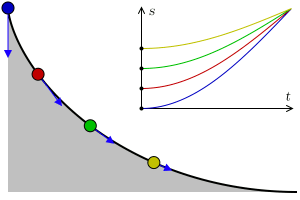1. The pendulum always takes the same time for each oscillation, whatever may be the size of the swing? why?
2. Can earth's gravity be controlled or manipulated?
3. What is iso-chronous curve?
4. What is "virtual gravity" ?
We will attempt to answer these questions in this article.
When the metal ball is at the top of the curve , it is going to fall vertically. Hence entire acceleration due to gravity g acts on it. When the ball is at the bottom, it moves horizontally. Hence no "g" acts on it. From top to bottom, the ball moves in inclined planes. (the angle of inclination of the planes with gravity changes from 0 to 90 degree). Hence between top and bottom, only partial gravity acts. It is given by the formula g cos x (x =0 to 90) and it is called virtual gravity.
Now, g cos 0 = g.1 = g=9.8 at top
g cos 45 = g.0.707 = g=6.93 at mid way
g cos 90 = g.0 = g=0 at the bottom
Hence the gravity acting on the ball slowly decreases from 9.8 - 0 while it moves from top to bottom. The above curve is a partial iso-chronous curve. The full curve is shown below and its property is explained.
Whatever may be the starting point of the ball , it will always reach the lowest point in the "same time". It is because, at the top g = 9.8 m/sˆ2 acts, so it covers the long distance quickly because of high acceleration. At a mid point, only less g ( like 6.93 ) acts. Hence it covers the small distance slowly because of low acceleration. Wherever the ball starts in the curve, it will take same and equal time to reach the lowest point. Hence the name "iso-chronous curve" (iso-same; chrono - time).
While the pendulum oscillates, it describes a cycloid or isochronous curve as shown in the second figure. Hence the pendulum takes the same time for small and big oscillations. Time for oscillation only depends on its length. This principle was used in old wall clocks to measure time.
[Now we understand that the inclined planes reduces or controls the gravity. So they are widely used in children's play areas, swimming pools,parks, mountain roads etc.]
Note: The "g" is resolved into horizontal; and vertical components g cos x and g sin x respectively. Only g cos x acts on the metal ball.
-----------------------------------------------------------------


